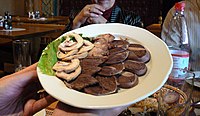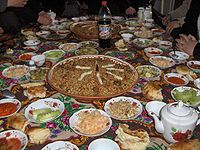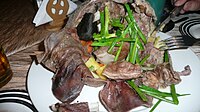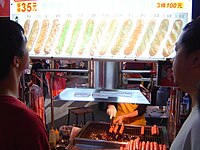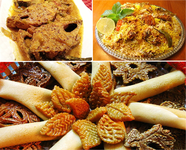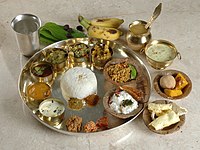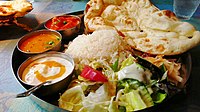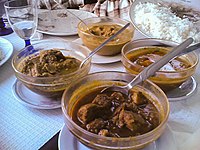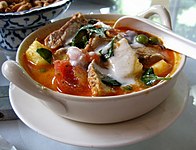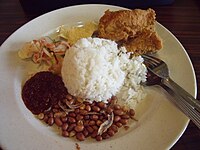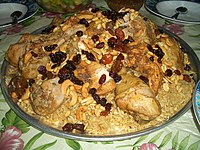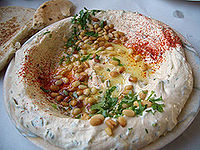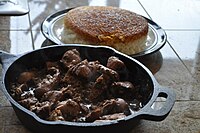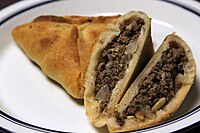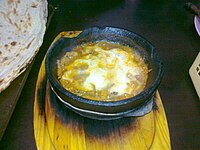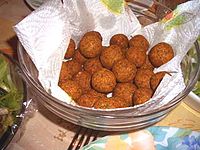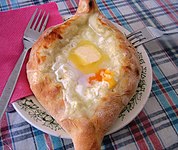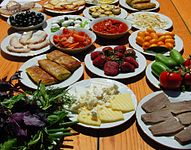List of Asian cuisines
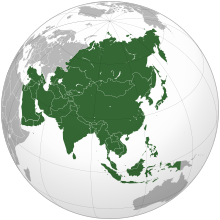
This is alist of Asian cuisines,by region. A cuisine is a characteristic style ofcookingpractices and traditions,[1]usually associated with a specificcultureor region. Asia, being the largest, most populous and culturally diversecontinent,has a great diversity of cuisines associated with its different regions.
Central Asian cuisine
[edit]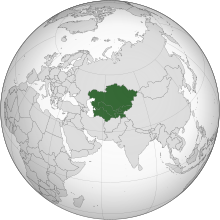
- Central Asian cuisine includes food fromKazakhstan,Kyrgyzstan,Tajikistan,TurkmenistanandUzbekistan.
- Bukharan Jewish cuisine– cuisine of theBukharan Jewswith great influence from Uzbek cuisine.
- Kazakh cuisine– cuisine ofKazakhstan.Traditional Kazakh cuisine revolves aroundmuttonandhorse meat,as well as variousmilk products.For hundreds of years, Kazakhs were herders who raised fat-tailed sheep, Bactrian camels, and horses, relying on these animals for transportation, clothing, and food.[2]
- Koryo-saram cuisine– cuisine of theKoryo-saram,descended from Korean cuisine and influenced by the cuisines of the formerSoviet Union.
- Kyrgyz cuisine– originating inKyrgyzstan,is similar in many respects to that of its neighbors, particularly Kazakh cuisine. Traditional Kyrgyz food includes mutton and horse meat, as well as milk products. The cooking techniques and major ingredients have been strongly influenced by the nation's nomadic way of life.
- Tajik cuisine– traditional cuisine ofTajikistan,has much in common with Afghan, Russian, and Uzbek cuisines.Plov,also calledosh,is the national dish in Tajikistan, as in other countries in the region. It consists of chunks of mutton,carrotsand rice fried in a large cast-iron cauldron similar to aDutch oven.Green teais the national drink. Traditional Tajik meals start with a spread of dried fruit, nuts,halva,and other sweets arrayed on the table in small dishes, and then progress to soup and meat, before finishing with plov.
- Turkmen cuisine– cuisine ofTurkmenistan.It is similar to that of the rest ofCentral Asia.Plov is the staple, everyday food, which is also served at celebrations. Turkmenistan is perhaps most famous for itsmelons,especially in the former Soviet Union, where it was once the major supplier. Meals are almost always served withnaan,Central Asianflat bread,known locally as "çörek".
- Uzbek cuisine– cuisine influenced by localagriculture,as in most nations. There is a great deal of grain farming in Uzbekistan, so bread and noodles are of importance, and Uzbek cuisine has been characterized as "noodle-rich".[3]Mutton is a popular variety of meat due to the abundance of sheep in the country and it is a part of various Uzbek dishes. Uzbekistan's signature dish ispalov(osh) made with rice, pieces of meat, grated carrots and onions.
- Central Asian cuisine
-
ATajikfeast
East Asian cuisine
[edit]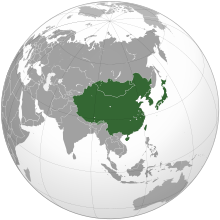
East Asian cuisine has evolved with common usage of oils, fats and sauces in the preparation of dishes.
- Chinese cuisine– TraditionalChinese cuisinesincludeAnhui,Cantonese,Fujian,Hunan,Jiangsu,Shandong,Sichuan,andZhejiang,[4]all of which are defined and termed per the respective regions within China where they developed. A number of different styles contribute to Chinese cuisine, but perhaps the best known and most influential are the Sichuan, Shandong, Jiangsu and Guangdong cuisines.[5]These styles are distinctive from one another due to factors such as available resources,climate,geography,history,cooking techniques and lifestyle. Many Chinese traditional regional cuisines rely on basic methods offood preservationsuch asdrying,salting,picklingandfermentation.[6]
- Chinese cuisine originated in what is known as the Eight Great Traditions, though it can be generalized into northern styles that feature oils and strong flavors derived from ingredients such as vinegar and garlic, while southern styles tend to favor fresh ingredients that are lightly prepared. It has become widespread throughout many other parts of the world — fromAsiato theAmericas,Australia,Western EuropeandSouthern Africa.In recent years, connoisseurs of Chinese cuisine have also sprouted inEastern EuropeandSouth Asia.American Chinese cuisineandCanadian Chinese foodare popular examples of local varieties. Local ingredients would be adopted while maintaining the style and preparation technique.
- Wine in China
- Great Traditions
- Eight Great Traditions – Regional cultural differences vary greatly amongst the different regions of China, giving rise to eight main regionalcuisines,or Eight Great Traditions ( bát đại thái hệ, Bā Dà Cài Xì)
- Anhuiis derived from the native cooking styles of theHuangshan Mountainsregion in China and is similar to Jiangsu cuisine. It is known for the use of wild herbs, from both land and sea, and simple methods of preparation.
- Cantonesecomes fromGuangdong Provincein southern China.[7]Due toGuangdong's location on the southern coast of China, fresh live seafood is prominent in Cantonese cuisine. Canton has long been a trading port and many imported foods and ingredients are used in Cantonese cuisine.Char siuis a popular way to flavor and prepare pork in Cantonese cuisine.[8]
- Fujianis one of the native Chinese cuisines derived from the native cooking style of theprovinceofFujian,China. Many diverseseafoodsand woodland delicacies are used, including a myriad of fish, shellfish and turtles, along withedible mushroomsandbamboo shoots,provided by the coastal and mountainous regions of Fujian.[9]
- Hunan,sometimes calledXiang cuisine,consists of the cuisines of theXiang Riverregion,Dongting Lakeand westernHunanProvince, in China. The cuisine is well known for its hot spicy flavor, fresh aroma and deep color. Common cooking techniques include stewing, frying, pot-roasting, braising, and smoking. Due to the high agricultural output of the region, ingredients for Hunan dishes are many and varied.
- Jiangsuis derived from the native cooking styles of theJiangsuregion in China. Food texture is often soft, but not to the point of mushy or falling apart. Other characters include the strict selection of ingredients according to the seasons, emphasis on the matching color and shape of each dish and emphasis on using soup to improve the flavor.
- Shandongin Chinese is more commonly known asLu cuisine,and is derived from the native cooking styles ofShandong,an eastern coastal province of China. Possibly Shandong's greatest contribution to Chinese cuisine has been in the area of brewing vinegar. Hundreds of years of experience combined with unique local methods have led to Shandong's prominence as one of the premier regions for vinegar production in China.
- Sichuanis a style of Chinese cuisine originating in theSichuan Provinceof southwestern China famed for bold flavors, particularly the pungency and spiciness resulting from liberal use ofgarlicandchili peppers,as well as the unique flavor of theSichuan peppercorn( hoa tiêu ).Peanuts,sesame paste,andgingerare also prominent ingredients in Sichuan cooking.[10]
- Zhejiangis derived from the native cooking styles of theZhejiangregion in China. Food made in the Zhejiang style is not greasy, having instead a fresh and soft flavor with a mellow fragrance.[11]
- Four Great Traditions – often considered the standouts of Chinese cuisine and due to their influence are proclaimed as the Four Great Traditions ( tứ đại thái hệ, Sì Dà Cài Xì).
- Cantonese
- Sichuan
- Shandong
- Huaiyang cuisine– often viewed as the representation of the entire Jiangsu cuisine.
- Chinese cultural subcuisines
- Chinese cuisines, by region
- Anhui cuisine
- Beijing cuisine
- Cantonese cuisine
- Chaozhou cuisine
- Chiuchow cuisine
- Fujian cuisine
- Guizhou cuisine
- Hainan cuisine
- Hakka cuisine
- Henan cuisine
- Hubei cuisine
- Hunan cuisine
- Jiangsu cuisine
- Jiangxi cuisine
- Manchu cuisine
- Northeastern Chinese cuisine
- Shaanxi cuisine
- Shandong cuisine
- Shanghai cuisine
- Shanxi cuisine
- Sichuan cuisine(Sichuan)
- Tianjin cuisine
- Tibetan cuisine
- Uyghur cuisine
- Yunnan cuisine
- Zhejiang cuisine
- Eight Great Traditions – Regional cultural differences vary greatly amongst the different regions of China, giving rise to eight main regionalcuisines,or Eight Great Traditions ( bát đại thái hệ, Bā Dà Cài Xì)
- Hong Kong cuisineis mainly influenced by Cantonese cuisine, non-Cantonese Chinese cuisine (especially Teochew, Hakka, Hokkien and the Jiangsu & Zhejiang), the Western world, Japan, and Southeast Asia, due to Hong Kong's past as a British colony and long history of being an international city of commerce.Fish balls,wonton noodle,egg waffle,andmilk teaare some of the most notable dishes, snacks, and drinks.
- Macau cuisine
- Japanese cuisineis known for its emphasis onseasonality of food(Tuần,shun),[13]quality of ingredients and presentation.Japanese regional cuisineincludes a vast array of regional specialties known askyōdo ryōriin Japanese, many of them originating from dishes prepared using local ingredients and traditional recipes.[14]Sushiandsashimiare both part of the cuisine of the island nation. TheMichelin Guidehas awarded Japanese cities by far the most Michelin stars of any country in the world (for example, Tokyo alone has more Michelin stars than Paris, Hong Kong, New York, LA and London combined).[15][16]
- Traditional cooking methods eschew the use of oils and fats, with a focus on featuring the delicate flavors of the natural ingredients. Due to an abundant seafood supply, the traditional Japanese diet featured minimal use of meat; however, modern Japanese cuisine includes an extensive variety of popular meat dishes. Japanese cuisine offers a vast array of regional specialties that use traditional recipes and local ingredients.
- Japanese wine
- Okinawan cuisineis the cuisine of the Japaneseisland of Okinawa.Due to the difference in culture, climate, vegetables and other ingredients between Okinawa and mainland Japan, Okinawan cuisine is very different from Japanese cuisine. The cuisine incorporated influence from Chinese cuisine andSoutheast Asiancuisine due to trade. Thesweet potato,introduced in Okinawa in 1605, became a staple food there until the beginning of the 20th century. An article about Okinawan food written byKikkomanstated that Goya (bitter melon) and Nabera (luffaor towel gourd) were "likely" introduced to Okinawa from Southeast Asia. SinceRyūkyūhad served as a tributary state to China, Okinawan cooks traveled toFujian Provinceto learn how to cook Chinese food; Chinese influence seeped into Okinawa in that manner. The same Kikkoman article states that the method ofdistillationofawamorilikely originated fromSiam(Thailand) and traveled to Okinawa during the 15th century. After the lord of theKagoshimaDomain subjugated Ryūkyū, Okinawan cooks traveled to Japan to studyJapanese cuisine,causing that influence to seep into Okinawan cuisine.[17]
- Nagoya cuisine
- Ainu cuisine
- Korean cuisineoriginated from ancientprehistoric traditionsin theKorean peninsula,evolving through a complex interaction of environmental, political, and cultural trends.[19]Korean cuisine is largely based upon rice, vegetables, and meats. Traditional Korean meals are noted for the number ofside dishes(banchan) that accompany steam-cooked short-grain rice.Kimchiis served often, sometimes at every meal. Commonly used ingredients includesesame oil,doenjang(fermented bean paste),soy sauce,salt, garlic, ginger,pepperflakes, andgochujang(fermented red chili paste).Korean regional cuisine(Korean:hyangto eumsik,literally "native local foods" ),[20]is characterized by local specialties and distinctive styles within Korean cuisine. The divisions reflected historical boundaries of the provinces where these food and culinary traditions were preserved until modern times.Korean barbecue,orgogi gui,refers to the Korean method ofgrillingbeef, pork, chicken, or other types of meat. Such dishes are often prepared at the diner's table on gas or charcoal grills that are built into the center of the table itself. It features cooking methods such assautéingand what is known in the West as barbecue. Strong flavors featuring spices derived from chili peppers can also be found in dishes such askimchi.[21]
- Goongjoong (Hangul:궁중) food: A splendid table setting that has been handed down since theThree Kingdoms periodsince central power was solidified. It is characterized by selecting various local ingredients and mixing them in various ways without being particularly biased.
- Food for the common people: food that the common people, who were most distributed by region, ate in a simple way. In general, it was influenced by theyangbanfamilies that existed in each region, but it was somewhat deteriorated, and in the lateJoseon Dynasty,it developed with the development of tavern culture. It is most of the food we enjoy now.

- Korean traditional liquormakgeolli(Hangul:막걸리) is a brewer made of rice. It is characterized by a subtle savory and slightly sweet taste and a slightly pungent feeling, and popularly consumed inSouth Koreaalong withsoju.It is nutritious because the nutrients of rice are melted.
- Korean royal court cuisine
- Korean temple cuisine
- North Korean cuisine
- South Korean cuisine
- Mongolian cuisine– local culinary traditions ofMongoliaandMongolianstyled dishes. The extremecontinental climatehas affected the traditional diet, so the Mongolian cuisine primarily consists ofdairy products,meat,and animal fats. Use ofvegetablesandspicesare limited.
- Taiwanese cuisine– MajorityHan Taiwanesecuisine and theAboriginal Taiwanesecuisine, however mixed with part of Japanese cuisine due to Imperial Japanese colonial legacies.
- East Asian cuisine
-
Due toGuangdong's location on the southern coast of China, fresh live seafood is a specialty inCantonese cuisine.
-
Sichuan cuisine– A Chengdu-style, hot-pot stew.
-
Many flavors of Taiwanese sausages are sold by night market vendors.
North Asian cuisine
[edit]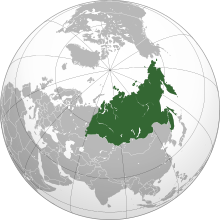
North Asian cuisine includes thecuisinesof the people fromNorth Asia.It mostly consists of the culinary traditions of the ethnic groups and indigenous people who live in the Asian part of theRussian Federation.Those cuisines have characteristics of Turkic and Mongolian cuisines.
South Asian cuisine
[edit]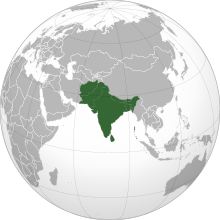
South Asian cuisineincludes thecuisinesfrom theIndian subcontinentand when included in the definition, also that ofAfghanistan.It has roots in South Asia, including practices taken from theHindubeliefs practiced by the large population found in the region, alongside in some regional cuisines, certain influences from neighboring regions and cultures, particularly from Muslim cultures of the Middle East and Central Asia. Dishes in this area of the world are known for their use of hot peppers, black pepper, cloves, and other strong spices along with the flavored butterghee.Common meats include lamb, goat and chicken; beef is not as common as in western cuisines because the tenets of the Hindu faith prohibit its consumption. Other staples of many of the cuisines include rice,chapatimade from wheat and barley, and beans.[21]The cuisine of South Asia has mostly indigenous roots, as well as influences practices taken from foreign origin empires.
Naan,a type offlat breadfrom the former regions, is a common part of meals in many parts of South Asia.
- Afghan cuisine– cuisine of the Afghan people, largely based upon Afghanistan's chief crops: cereals likewheat,maize,barleyand rice. Accompanying these staples are dairy products (yogurtandwheat), various nuts, and native vegetables, as well as fresh and dried fruits. Lamb is the primary meat for many Afghans, although Turkic peoples also eat horse. Afghanistan is also well known for itsgrapes.
- Bangladeshi cuisineis dominated byBengali cuisineand has been shaped by the diversehistoryand riverinegeography of Bangladesh.The country has atropical monsoon climate.Riceis the mainstaple foodof Bangladeshi people and it is served with a wide range ofcurries.SublimeBangladeshi dishes exhibit strongaromaticflavours; and often includeeggs,potatoes,tomatoesandaubergines.A variety ofspicesandherbs,along withmustard oilandghee,is used in Bangladeshi cooking. The main breads arenaan,porota,roti,bakarkhaniandluchi.Dalis the second most important staple food which is served with rice/porota/luchi.Fishis a staple in Bangladeshi cuisine, especiallyfreshwater fish,which is a distinctive feature of the country's gastronomy. Major fish dishes includeilish(hilsa),pabda(butterfish),rui(rohu),pangash(pangas catfish),chitol(clown knifefish),magur(walking catfish),bhetki(barramundi) andtilapia.Meat consumption includesbeef,lamb,venison,chicken,duck,squabandkoel.Vegetable dishes, either mashed (bhorta), boiled (sabji), or leaf-based (saag), are widely served. Seafood such aslobstersandshrimpsare also often prevalent.
- Bhutanese cuisineemploys a lot of red rice (like brown rice in texture, but with a nutty taste, the only variety of rice that grows at high altitudes), buckwheat, and increasingly maize. The diet in the hills also includes chicken, yak meat, dried beef, pork, pork fat, and mutton. When offered food, one saysmeshu meshu,covering one's mouth with the hands in refusal according to Bhutanese manners, and then gives in on the second or third offer.
- Hazaragi cuisinerefers to the food and cuisine of theHazara peoplein Afghanistan and western Pakistan (Balochistan province). The food of the Hazara people is strongly influenced by Central Asian, South Asian and Persian cuisines and shares similarities with neighboring regional cuisines in Afghanistan and Central Asia, however, there are certain dishes, culinary methods and styles of cooking that are unique to the Hazara people. It is largely centered on bread, meats and dairy products, and uses a large amount of oil in its cooking.
- Indian cuisineis characterized by its sophisticated and subtle use of manyIndian spices[22]andvegetables,herbs,andfruitsgrown across India.[22]There is also the widespread practice ofvegetarianismacross its society. Considered by some to be one of the world's most diverse cuisines, each family of this cuisine is characterized by a wide assortment of dishes and cooking techniques. As a consequence, Indian cuisine varies from region to region, reflecting thevaried demographicsof the ethnically diverseIndian subcontinent.[23]India'sreligious beliefsandculturehas played an influential role in the evolution of its cuisine. However, cuisine across India has also evolved with the Indian subcontinent's cross-cultural interactions with the neighboringMiddle East,Southeast Asia,East Asia,andCentral Asia,making it a unique blend of various cuisines acrossAsia.[24][25]Thecolonial periodintroduced European cooking styles to India adding to its flexibility and diversity.[26][27]Indian cuisine has also influenced cuisines across the world, especially those fromSoutheast Asia.[28][29][30]In particular,curryhas been widely adopted in cuisines around the world.
- North Indian cuisines
- South Indian cuisines
- Kerala cuisine-Sadhyameans "banquet" inMalayalam.It is a typical feast of the people of Kerala.
- Tamil cuisine
- Andhra cuisine
- Cuisine of Karnataka
- Telangana - Hyderabadi cuisine
- East Indian cuisines
- Bengali cuisineis a style of food preparation originating inBengal,a region in easternSouth Asiawhich is now divided between the Indian states ofWest Bengal,Tripura,andBarak ValleyofAssamand the independent country of Bangladesh. Bengali food has inherited a large number of influences, both foreign and South Asian, arising from historical and strong trade links with many parts of the world.
- Cuisine of Jharkhand
- Oriya cuisine
- North East Indian cuisines
- West Indian cuisines
- Maharashtrian cuisine
- Malvani cuisine
- East Indian Cuisine (East Indiansare an ethnic group from Bombay in the West of India) The East Indian cuisine[31]is distinct to the community and includes delicacies such as the vajri curry or goat tripe curry,[32]chicken tope,[33]sorpotel, khudi curries and many more.
- Goan cuisine
- Parsi cuisine
- Gujarati cuisine
- Rajasthani cuisine
- Maharashtrian cuisine
- Other Indian cuisines
- Maithil cuisine
- Maldivian cuisine
- Nepalese cuisine
- Pakistani cuisine
- Sri Lankan cuisine
- South Asian cuisine
-
Some of the popular Afghan dishes, from left to right: 1. Lamb grilled kebab (seekh kabab); 2.Kabuli palawand salad; 3.Tandoori chicken;and 4.Mantu(dumplings).
-
Traditional Bangladeshi meal:mustard seedilishcurry,Dhakaibiryaniandpitha;similar toEast Indiancuisine.
-
South Indian stylevegetarianthali.
-
North Indian stylevegetarianthali.
Southeast Asian cuisine
[edit]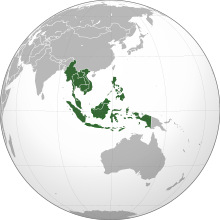
Southeast Asian cuisine emphasizes lightly prepared dishes with strong aromas, featuring such flavors aslemongrass,fermented fish sauceandpastes,andginger.[34]Ingredients in the region contrast with the ones in the Eastern Asian cuisines, substitutingfish saucesfor soy sauce and including such ingredients asgalangal,tamarindandlemongrass.Cooking methods includestir frying,boiling and steaming.[21]
- Bruneian cuisineis similar to, and heavily influenced by, the cuisine of neighboringMalaysia,Singapore,[35]and Indonesia, with additional influences from China, India and Arab.
- Burmese cuisinehas been influenced greatly by China, India and Thailand. However, Burmese cuisine has retained unique preparation techniques and distinct flavors, and there are many regional variations of "standard" dishes. The Burmese eat with their right hand, forming rice into a small ball with only the fingertips and mixing this with various morsels before popping it into their mouths. The Burmese eat a great variety of vegetables and fruits, and a variety of meat. A very popular vegetable is thedanyin thi,which is usually boiled or roasted and dipped in salt, oil and sometimes, cooked coconut fat.
- Cambodian cuisineencompasses the cuisines of allethnic groups in Cambodia,whereasKhmer cuisinerefers specifically to the cuisine of the ethnicKhmers.Over time, Khmer cuisine has absorbed elements from Indian, Chinese and more recently French cuisine, and due to historic interaction and shared influences, Cambodian cuisine has many similarities with neighboring Thai, Vietnamese, and Lao cuisines.
- Christmas Island cuisinehas influences from both Australian cuisine and other Asian cuisines, particularly Malaysian and Indonesian.
- Cuisine of East Timoris the cuisine of one of the newest Southeast Asian countries.
- Filipino cuisinehas evolved over several centuries from itsAustronesianorigins to a mixed cuisine with many Hispanic, Chinese, American, and other Asian influences adapted to indigenous ingredients and the local palate.[36][37][38][39]For more information refer to:Filipino cuisine; regional specialties.
- Kapampangan cuisineis the cuisine native to theKapampangan peopleoriginating from the province ofPampanga,inCentral Luzon.One of the best examples of Kapampangan dish issisig,which is a popular dish across the Philippines.
- Bicol's cuisine is noted for its gastronomic appetite for the fiery or chili-hot dishes and coconut milk dishes. Perhaps the most well-known Bicolano dish is the very spicyBicol express.The region is also the well-known home ofnatongalso known aslaingorpinangat(pork or fish stew intaroleaves).
- Being surrounded by waters and rich land, Visayas is abundant in marine and land products as indicated in variousVisayan cuisines.Few examples of famous Visayan foods includeCebu'sLechonvariant,Iloilo'sLa Paz batchoy,Bacolod'sinasalandpiaya,andLeyte'sroscas,humba,moron,andbukayo.
- Mindanao cuisine's dishes are richly flavored with the spices common toSoutheast Asia.Some parts of Mindanao are predominantlyMuslim,where pork is rarely consumed. Most notable dishes in Mindanao cuisine are:Satti,Sambal,Tiyula itum,andZamboanga'sAlfajor,curacha, and rebosao.
- Hmong cuisineis the cuisine of theHmong people,originally ofChina,now adiasporaacrossSoutheast Asiawith a significantHmong Americancommunity in the United States.
- Indonesian cuisineis diverse, in part because Indonesia is composed of approximately 6,000 populated islands.[40]Many regional cuisines exist, often based uponculturaland foreign influences.[40][41][42]For example,Sumatrancuisine often has Middle Eastern and Indian influences, featuring curried meat and vegetables, whileJavanese cuisineandSundanese cuisineare more indigenous.[40]
- Acehnese cuisineis the cuisine of theAcehnese peopleofAcehin most westernSumatra.
- Balinese cuisineis the cuisine and culinary traditions ofBalinese peoplefrom the volcanic island ofBali.
- Banjar cuisine:is the cooking tradition and cuisine ofBanjar peopleofSouth KalimantaninIndonesia.
- Batak cuisineis the cuisine and cooking traditions ofBatak ethnic groups,predominantly found inNorth Sumatraregion.
- Indo cuisineis afusioncooking and cuisine tradition, mainly existing inIndonesia(nationwide) and theNetherlands,as well asBelgium,South AfricaandSuriname.
- Indonesian Arab cuisineis characterized by the mixture ofMiddle Eastern cuisinewith localIndonesian style.Indonesian Arabsbrought their legacy of Arab cuisine originally fromHadhramaut,HejazandEgypt.
- Indonesian Chinese cuisineis characterized by the mixture ofChinesewith localIndonesian style.Chinese Indonesiansbring their Chinese cuisine legacy.
- Indonesian Indian cuisineis characterized by the mixture ofIndian cuisinewith localIndonesian style.Indian Indonesiansbring their Indian cuisine legacy.
- Javanese cuisineis the cuisine ofJavanese people.In wider sense, Javanese cuisine might also refer to the cuisine of the whole people ofJavaIsland, Indonesia; which also includes Sundanese in West Java,BetawiinJakartaandMadureseonMadura Islandoff East Java.
- Betawi cuisineis rich, diverse and eclectic cuisine ofBetawi peopleinJakartadue to the Betawi people that create them were composed from numbers of regional immigrants that came from various places in the archipelago.
- Madurese cuisineis the cuisine tradition ofMadurese peopleinMadura islandon the northeastern coast ofJava.
- Sundanese cuisineis the cuisine ofSundanese peopleofWest Java,Indonesia. In Sundanese restaurants, it is common to eat with one's hands. They usually servekobokan,a bowl of tap water with a slice of lime for handwashing.
- Makassar cuisineis the cuisine of theBuginese peopleandMakassar peopleinSouth Sulawesi.
- Malay cuisineis the cuisine ofMalay peoplewith many regional and foreign influences.
- Manado cuisineis the cooking tradition of theMinahasan peopleof North Sulawesi. This cuisine has influences by Eurasian cuisine, especiallyDutch cuisine.
- Padang food,also known as Minangkabau cuisine, is the cuisine of theMinangkabau peopleofWest Sumatra,Indonesia. It is among the most popular food inMaritime Southeast Asia.It is known across Indonesia asmasakan Padang.
- Palembang cuisineis the cuisine of thePalembang peopleinSouth Sumatra.
- Peranakan cuisinecombinesChinese,Malay,Javaneseand other influences into a unique blend.
- Laotian cuisineis thecuisineofLaos,which is distinct from other Southeast Asian cuisines. Laos shares borders with neighboring countries and as a result, Lao cuisine has strongly influenced the neighboring cuisine of Northeastern Thailand (Isan) and some Lao culinary influences have also reached Cambodia[43]and Northern Thailand (Lanna).[44]
- Malaysian cuisinereflects the multicultural aspects ofMalaysia.Malaysia is an amalgamation of three major races, Malay, Chinese and Indian, as well as a myriad of ethnic groups from Sabah and Sarawak. The potpourri is enriched further with the influence of the Thai from the north, Indonesian from the south, Filipino from the east, and British, Dutch and Portuguese through hundred years of colonization.[45]
- Malay cuisineis the cuisine ofMalay peoplewith many regional and foreign influences. For examples, cuisine ofJohoroften has Middle Eastern and Javanese influences while cuisine ofKelantanoften has Thai influences.
- Malaysian Chinese cuisineis characterized by the mixture ofChinesewith local ingredients.
- Malaysian Indian cuisineis characterized by the mixture ofIndianwith local ingredients.
- Sarawakian cuisineis the cuisine of Sarawak, Malaysia
- Sabahan cuisineis the cuisine of Sabah, Malaysia with influences fromFilipino cuisineandIndonesian cuisine
- Peranakan cuisinecombines Chinese,Malayand other influences into a unique blend. Peranakan inPenangoften has Thai influences whileMelakaandSingaporeoften has Indonesian influences.
- Eurasian cuisinecombinesKristang,Dutch,British,Malayand other influences into a unique blend, predominantly found inMelaka
- Singaporean cuisineis similar to, and heavily influenced by the cuisine of neighboringMalaysia,as a product of centuries of cultural interaction owing to Singapore's strategic location.[46]The predominant cuisine in Singapore isChinese,[46]along withMalay,Indian[46]andEnglishtraditions since the founding of Singapore by the British in the early 19th century.
- Thai cuisinecan be described as four regional cuisines corresponding to the four main regions of the country:Northern,Northeastern (orIsan),Central,andSouthern.[47]A fifth cuisine is Thai royal cuisine, based on the palace cuisine of theAyutthaya kingdom(1351–1767 CE), which was influential upon the cuisine of the Central Thai plains.[47]Each cuisine has similarities to foods and cuisines in neighboring countries and regions, including theCuisine of Burma,Yunnan cuisine,Lao cuisine,Cambodian cuisineandMalaysian cuisine.[47]
- Vietnamese cuisineis a style of cooking derived from Vietnam with Chinese and French influence.Fish sauce,soy sauce, rice, freshherbs,fruits and vegetables are commonly used. Vietnamese recipes utilize a diverse range of herbs, includinglemongrass,mint,Vietnamese mint,long corianderandThai basilleaves.
- Southeast Asian cuisine
-
Personal serving ofNasiBali,inIndonesia,rice surrounded by numbers of side dishes includingsate lilit.
-
Philippine adobois a popular Filipino dish and cooking process inFilipino cuisine.
-
Food stall inChiang Mai,Thailandselling ready-cooked food.
-
Bò 7 món(literally "seven courses ofbeef"inVietnamese) is a set selection of beef dishes inVietnamese cuisine.
West Asian cuisine
[edit]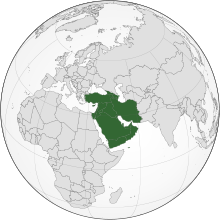
- West Asian cuisine,is the cuisine of the various countries and peoples ofWest Asia.Despite their similarities, there are considerable differences inclimateandculture,so the term is not definitive. The cuisine of the region is diverse while having a degree of homogeneity.[48]Many West Asian dishes are made with a paste calledtahini.Tahini is asesamepaste made with hulled seeds, unlike its East Asian counterpart. It is used to make such popularmeze,or appetizers, asbaba ghanoushandhummusalong with pungent dipping sauces served withfalafel,keftesorkoftaand vegetables.[49]Hummus is made fromchickpeas,which are staples of the diet. Some commonly used ingredients includeolivesandolive oil,lamb,[48]pitas,honey,sesame seeds,dates,[48]sumac,chickpeas,mintandparsley.Some popular dishes includekibbeh[50]andshawarma.[51]
- Arab cuisine of the Persian Gulf- Arab cuisine of thePersian Gulftoday is the result of combination of diverse cuisines, incorporating Levantine, Indian, Chinese, and Persian cooking styles, and many items not originally indigenous to thePersian Gulfregion, which were most probably imported on thedhowsand thecaravans.
- Assyrian cuisine
- Bahraini cuisinerefers to the cuisine ofThe Kingdom of Bahrain,a smallislandstate near the western shores of thePersian Gulf.Bahrain produces only a small amount of its food requirements due to limited land space, and imports much of its food.[52]Its primary crops aredates,bananas,citrus fruits,pomegranates,mangoes,cucumbersand tomatoes.[52]
- Cypriot cuisine
- Egyptian cuisine
- Emirati cuisine
- Iranian cuisine- Persian cuisine is diverse, with each province featuring dishes, culinary traditions and styles distinct to its region.
- Abgooshtis an Iranian stew usually made with lamb and vegetables
- Caspian cuisine
- Iraqi cuisineorMesopotamian cuisine,has a long history going back some 10,000 years - to theSumerians,BabyloniansandAssyrians.[53]Tabletsfound in ancient ruins in Iraq show recipes prepared in the temples during religious festivals - the first cookbooks in the world.[53]
- Kurdish cuisineconsists of a wide variety of foods prepared by theKurdish peoplethat have got many traditions from their homeland,Kurdistan.
- Kuwaiti cuisine- thenational dishof Kuwait known asmachboos(Arabic:مكبوس) consists mainly of mutton orchickenplaced over or mixed in a large mass of well-cooked and prepared rice.
- Mizrahi Jewish cuisineis based largely on fresh ingredients, as marketing was done in the localsouq.
- Omani cuisineis generally very simple, with the aid of many spices andmarinadesto complete a dish, which usually consists of chicken, fish, and mutton. Unlike many other Asian nations, Omani cuisine is not spicy, and varies between regions.
- Qatari cuisine
- Saudi Arabian cuisine- Food staples include lamb,grilled chicken,falafel(deep-friedchickpeaballs),shawarma(spit-cooked sliced lamb),mutabbaqandFul medames.[54]Arabic unleavened bread, orkhobz(خبز), is eaten with almost all meals, and is often used as an edible utensil to scoop foods.[54]
- Kabsais considered by many as Saudi Arabia's national dish.
- Turkish cuisineis largely the heritage ofOttoman cuisine,which can be described as a fusion and refinement ofCentral Asian,West AsianandBalkancuisines.[55][56]Turkish cuisine has in turn influenced those and other neighboring cuisines, including that of western Europe.
- Yemeni cuisine- The most common Yemeni dishes include:Aseed,Bint Al-Sahn,Fahsa,Fatoot,Fattah,Ful medames,Hareesh,Jachnun,Kabsa,Karees,Komroh,Mandi,Mateet,Mutabbaq,Saltah,Samak Mofa,Shafut,Shakshouka,Thareed,andZoam.
- Mandiis a traditional Yemeni dish usually made from meat (lamb or chicken), basmati rice, and a mixture of spices.
- Levantine cuisine– traditionalcuisineofOttoman Syria,now usually called theLevant,known in Arabic as theBilad ash-Sham.This region shared many culinary traditions under theOttoman Empirewhich continue to be influential today. It covers the modern states ofSyria,Palestine,Lebanon,Jordan,Israel,Northern Iraq,northwestIraq(the province of Mosul), and parts of southern Turkey nearAdana,Gaziantep,AntakyaandMardin.
- Palestinian cuisineconsists of foods from or commonly eaten byPalestinians,whether in Palestine, Israel, Jordan, refugee camps in nearby countries, or by thePalestinian diaspora.
- Israeli cuisinecomprises a mixture ofdishes—from those brought back to Israel by Jews from theDiaspora,those from Jews who remained in the region, and those adopted from surrounding Arab inhabitants. Since before the establishment of the modernState of Israelin 1948, and particularly since the late 1970s, an Israelifusion cuisinehas developed.[57]
- Ancient Israelite cuisine
- Israeli wine
- Ptitim– Israeli toasted pasta shaped like rice or little balls.
- Jordanian cuisine
- Lebanese cuisineincludes an abundance of starches,fruits,vegetables, fresh fish andseafood;animal fats are consumed sparingly. Poultry is eaten more often than red meat, and when red meat is eaten it is usually lamb on the coast and goat meat in the mountain regions.
- Syrian cuisineis a diffusion of the cultures of civilizations that settled in Syria, particularly during and after the Islamic era beginning with the Arab Umayyad conquest, then the eventual Persian-influenced Abbasids and ending with the strong influences of Turkish cuisine, resulting from the coming of the Ottoman Turks.
- Syrian Jewish cuisine
- South Caucasus cuisineis the cuisine of the various countries and peoples of theSouth Caucasus,also known as Transcaucasia.
- West Asian foods and dishes
-
Syrians are renowned for producing dried apricot paste
-
ChickenFesenjānwith Persian rice, an Iranian dish
-
Fahsais a famous Yemeni dish, containing beef or lamb meat cooked in a stony pot called Madara.
-
Falafelballs
-
Doner kebab,Istanbul,Turkey
-
AdjarianKhachapurifrom Georgia
-
ArmenianGhapamamade with butternut squash, instead of pumpkin
-
Light snacks ofAzerbaijani cuisine
See also
[edit]- Eastern Arabian cuisine
- Asian cuisine
- Fusion cuisine
- List of cuisines
- List of dishes from the Caucasus
- Mediterranean cuisine
References
[edit]- ^"Cuisine."Archived2013-04-26 at theWayback MachineThefreedictionary.comArchived2013-05-26 at theWayback Machine.Accessed June 2011.
- ^"Kazakhstan".foodbycountry.com.Archivedfrom the original on May 20, 2011.RetrievedApril 18,2011.
- ^"The noodle-rich cuisine of Uzbekistan"Archived2007-12-11 at theWayback Machine,The Village Voice,Dining, 19 January 1999.
- ^"Fujian Cuisine.Archived2013-07-31 at theWayback MachineBeautyfujian.comArchived2011-07-10 at theWayback Machine.Accessed June 2011.
- ^"Regions of Chinese food-styles/flavors of cooking."Archived2011-10-05 at theWayback MachineUniversity of KansasArchived2011-10-05 at theWayback Machine,Kansas Asia Scholars. Accessed June 2011.
- ^J. Li & Y. Hsieh.Traditional Chinese Food Technology and Cuisine.Asia Pacific Journal of Clinical Nutrition.
- ^Hsiung, Deh-Ta. Simonds, Nina. Lowe, Jason. [2005] (2005). The food of China: a journey for food lovers. Bay Books.ISBN978-0-681-02584-4.p17.
- ^TVB. "TVBArchived2010-11-01 at theWayback Machine."Quảng đông thái tối cụ đa nguyên phanh điều phương pháp.Retrieved on 2008-11-19.
- ^Từ, văn uyển (2005),Trung quốc ẩm thực văn hóa khái luận,Thanh hoa đại học xuất bản xã, pp. 79–80
- ^Marshall Cavendish Corporation (2007).World and Its Peoples: Eastern and Southern Asia.Marshall Cavendish. p. 126.ISBN9780761476313.Archivedfrom the original on January 13, 2023.RetrievedNovember 15,2015.
- ^"Beijing 2008 Olympics - Zhejiang Cuisine".People's Daily Online. 2008.Archivedfrom the original on June 5, 2011.RetrievedSeptember 22,2008.
- ^Bourdain, Anthony(2001).A Cook's Tour: Global Adventures in Extreme Cuisines.New York, NY:Ecco.ISBN0-06-001278-1.
- ^"A Day in the Life: Seasonal Foods"Archived2013-01-16 at theWayback Machine,The Japan Forum Newsletter No. September 14, 1999.
- ^"Japanese Cuisine.Archived2011-06-25 at theWayback MachineThefoodieshandbook.co.ukArchived2016-02-18 at theWayback Machine.Accessed July 2011.
- ^(in Japanese)"“ミシュランガイド đông kinh ・ hoành bang ・ liêm thương 2011” を phát hành tam つ tinh が14 hiên, nhị つ tinh が54 hiên, nhất つ tinh が198 hiên に "Archived2010-11-29 at theWayback Machine,Michelin Japan, November 24, 2010.
- ^Tokyo is Michelin's biggest starArchived2011-10-12 at theWayback MachineFrom The Times November 20, 2007
- ^Ishige, Naomichi. "Food Forum OkinawaArchived2008-05-17 at theWayback Machine."Kikkoman.Retrieved on November 30, 2009.
- ^The Chosun Ilbo."Hanjeongsik, a full-course Korean meal."English.chosun.comArchived2003-07-07 at theWayback Machine.Accessed 6/11/2008.
- ^"Korean Cuisine (한국요리 hàn quốc liêu lý )"(in Korean).Naver/Doosan Encyclopedia.Archived fromthe originalon December 10, 2012.RetrievedMarch 28,2009.
- ^향토음식Archived2011-07-14 at theWayback MachineNateKorean-English Dictionary
- ^abcLe, C.N. (2008)."Asian Cuisine & Foods".Asian-Nation: The Landscape of Asian America.Archivedfrom the original on January 14, 2009.RetrievedDecember 18,2008.
- ^ab"Indian Cuisine."Archived2018-02-19 at theWayback MachineVisitSingapore.comArchived2018-05-07 at theWayback Machine.Accessed July 2011.
- ^"www.indiaat60.in/backgrounders/[email protected]"(PDF).Archived fromthe original(PDF)on October 11, 2017.RetrievedMay 26,2013.
- ^Chandra, Sanjeev (February 7, 2008)."The story of desi cuisine: Timeless desi dishes".The Star.Toronto. Archived fromthe originalon October 26, 2008.
- ^"Indian Grocery Online, Food Shopping Store, Buy, Indian Cuisine".Archived fromthe originalon July 26, 2009.RetrievedMay 26,2013.
- ^"Foreign Influences in Modern Indian Cooking".Archived fromthe originalon July 21, 2010.RetrievedMay 26,2013.
- ^"History of Indian Food and Cooking".Archivedfrom the original on May 26, 2013.
- ^"Food - VegVoyages".Archivedfrom the original on June 28, 2009.
- ^"Food & Recipes - Asia Society".Archived fromthe originalon May 25, 2001.
- ^"Archived copy"(PDF).Archived fromthe original(PDF)on October 3, 2008.RetrievedMay 26,2013.
{{cite web}}:CS1 maint: archived copy as title (link) - ^"Of Vajri Curries and Trotter Khudis - East Indians? | TheWingedFork".The Winged Fork.July 25, 2017.Archivedfrom the original on October 21, 2018.RetrievedOctober 21,2018.
- ^"Goat Tripe - Vajri Khudi Curry: East Indian Series | TheWingedFork".The Winged Fork.May 4, 2018.Archivedfrom the original on November 16, 2018.RetrievedOctober 21,2018.
- ^"Special East Indian Chicken Tope - East Indian Series | TheWingedFork".The Winged Fork.October 13, 2017.Archivedfrom the original on October 21, 2018.RetrievedOctober 21,2018.
- ^Fieldhouse, Paul.The World Religions Cookbook.Greenwood Press. p. 3.
- ^"Cuisine of Brunei".ifood.tv. Archived fromthe originalon May 27, 2012.RetrievedSeptember 30,2010.
- ^"Philippine Cuisine."Archived2011-06-16 at theWayback MachineBalitapinoy.netArchived2011-07-23 at theWayback Machine.Accessed July 2011.
- ^Alejandro, Reynaldo (1985).The Philippine cookbook.New York, New York: Penguin. pp. 12–14.ISBN978-0-399-51144-8.Archivedfrom the original on January 13, 2023.RetrievedFebruary 23,2019.
- ^Civitello, Linda (2011).Cuisine and Culture: A History of Food and People.John Wiley and Sons. p. 263.ISBN978-1-118-09875-2.Archivedfrom the original on January 13, 2023.RetrievedFebruary 23,2019.
- ^Philippines Country Study Guide.Int'l Business Publications. 2007. p. 111.ISBN978-1-4330-3970-6.
- ^abc"Indonesian Cuisine."Archived2017-08-23 at theWayback Machine.Accessed July 2011.
- ^"Indonesian food."ArchivedSeptember 10, 2011, at theWayback MachineBelindo.comArchived2011-09-07 at theWayback Machine.Accessed July 2011.
- ^"Indonesian Cuisine".Diner's Digest. Archived fromthe originalon April 9, 2011.RetrievedJuly 11,2010.
- ^"Stung Treng".Archived fromthe originalon June 13, 2010.
- ^"Thai Food - Regional Thai Cuisine by Sawadee.com".Archived fromthe originalon September 17, 2011.
- ^"What is Malay Food?"Archived2013-05-25 at theWayback MachineMalaysianfood.netArchived2013-06-06 at theWayback Machine.Accessed July 2011.
- ^abc"Singapore Food."Archived2011-07-05 at theWayback MachineSingaporefoodhistory.comArchived2011-07-05 at theWayback Machine.Accessed July 2011.
- ^abc"Modern Thai"Archived2013-05-27 at theWayback Machine(food).Sabaiaz.comArchived2013-05-27 at theWayback Machine.Accessed July 2011.
- ^abc"The Middle East: Background."Archived2017-05-26 at theWayback Machine,Globalgourmet.comArchived1998-01-26 at theWayback Machine.Accessed January 2007.
- ^Tahini: The Taste of Healthy Middle Eastern CuisineArchived2016-07-23 at theWayback Machine,The New York Times,October 19, 2009. Last visited January 29, 2010.
- ^Daisy Martinez (2010).Daisy: Morning, Noon and Night: Bringing Your Family Together with Everyday Latin Dishes(Hardvocer ed.). Atria. p.336.ISBN978-1-4391-5753-4.
- ^Philip Mattar (2004).Encyclopedia of the Modern Middle East & North Africa(Hardcover ed.). Macmillan Library Reference. p. 840.ISBN0-02-865771-3.
- ^abCuisine in BahrainArchived2011-05-04 at theWayback Machine.Allo' Expat BahrainArchived2011-05-02 at theWayback Machine(Website). Accessed April 2011.
- ^ab"Foods of Iraq: Enshrined With A Long History - ThingsAsian".www.thingsasian.com.Archivedfrom the original on May 13, 2011.
- ^ab"Food in Saudi Arabia"Archived2012-09-05 at theWayback Machine.Food in Every Country (website). Accessed May 2010.
- ^Nur İlkin - A Taste of Turkish cuisine
- ^Aarssen, Jeroen; Backus, Ad (2000).Colloquial Turkish.Routledge.p. 71.ISBN978-0-415-15746-9.Archivedfrom the original on October 13, 2017.RetrievedFebruary 23,2019.
- ^Gold, RozanneA Region's Tastes Commingle in IsraelArchived2011-09-10 at Wikiwix (July 20, 1994) inThe New York TimesRetrieved 2010–02–14
External links
[edit] Media related toCuisine of Asiaat Wikimedia Commons
Media related toCuisine of Asiaat Wikimedia Commons

